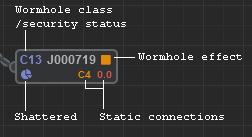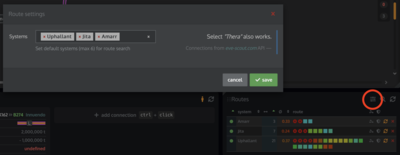User:Lord Finnbar
User:Lord Finnbar
Draft Pages User:Lord Finnbar/Draft
| This page is specific to EVE University. Other corporations or groups in the game may operate differently. For a summary of EVE University's rules and code of conduct, see EVE University Rules. |
Pathfinder is a free and open-source wormhole mapping tool. This tool allows groups of players to share mapped wormhole connections, intel, and cosmic signature information.
Mapping is essential to coordinate EVE University communities' scanning and exploration and is vital for Wormhole Community to ensure they have full knowledge of nearby wormholes. EVE University hosts a private Pathfinder for its members and was introduced in November 2019 as a replacement for our old EVE-Wspace tool.
Contents
Accessing the mapper
- Go to https://pathfinder.eveuniversity.org/
- Use SSO login and login EVE Online account.
- Select required map. Usually a community map, but personal or shared maps can be created.
Reading the map
The map is made of systems of any security level, and the connections between them. The map will show some of their information in compact form. To see the complete set of information about the system, select it on the map and look at the adjacent panels.
Connections
Connections between systems will change shape and color depending on their properties. These are user-defined and rely upon capsuleers to specify this information by right-clicking on the connection on the map.
- Wormhole size limit is indicated by a letter on the wormhole
- Small and medium wormholes have dashed lines
- Gate Connections are straight with blue cores
- Reduced and critical mass wormholes have yellow and red cores
- End-of-life (EOL) wormhole connections have purple outlines
- If Signature Overlay is enabled the wormhole will show its type at its ends
- Bubbled holes have large clear circles over the end of the connection
Managing information
Adding Systems
There are two ways to add systems.
- Automatically by Pathfinder as they are jumped into
- Manually create systems by right-clicking on the map
To move a system on the map, left-click and hold while the mouse is over where the class of the wormhole (or security status of the system) is specified, and subsequently re-position the system to where you wish. Clicking and dragging on any other part of the box will attempt to create a connection to another system, and that will be visible by the underlying animation.
Adding Connections
After a system has had another system added to it with a wormhole connection this can be linked to a signature in that system. Simply click the "leads to " attribute on the WH signature and select the corresponding system once the new system is present. Setting this will automatically add mass and size limit info on the connection if the wormhole was not K162.
Wormhole connection health should be subsequently verified and set by right-clicking the wormhole connection. This way you can set the mass criticality and end of the lifetime of the connection. EOL connections are automatically deleted 4h 15m after the status is set. The "preserve mass" option is for informing other map users to not waste the mass of this wormhole.
Adding signatures
First, make sure the correct system selected in Pathfinder. Signatures can be added imported in bulk or individually. It is recommended to import them in bulk as it is much faster and easier to keep the system up-to-date.
To quickly bulk import signatures, follow these steps:
- Make sure you have the correct system selected in Pathfinder
- Open the Signature Reader from the Pathfinder Signatures pane
- Copy all signatures (CTRL + A then CTRL + C) from the in-game scan window
- Paste the signatures (CTRL + V) into the signature window
- Verify that the correct system signatures are being updated
- Select "Update Signature"
To add a single signature manually, follow these steps:
- Make sure you have the correct system selected
- Click the "+" button in the top right corner of the signatures panel
- Add the full Signature ID (ex. ABC-123 with hyphen) shown in the signatures list
- Add signature group, type, and description
- Press the "+" button on this row of information
If a signature already existed in the system, the "Last Updated" timer will reset when the signature is updated.
"Lazy delete" option can be used when importing all the signatures in a system. With lazy delete, all old signatures that are not included in the new bulk import will be deleted. This allows for completely refreshing a system and clearing out any old signatures.
There is also a more detailed signature reader. To open it click the clipboard icon at the top right corner of the signatures panel. This works the same way as simply pasting the signatures to Pathfinder but with a preview window.
Preexisting signatures can also be edited or deleted in the signatures panel. Simply click the attribute you want to change.
Keeping content updated
Even after you have fully mapped the respective systems in your area of interest and added that information into Pathfinder, it is important to keep it continuously updated.
Signature updates
As you travel through systems on the map, establish the habit of updating signatures as you warp through the system, even if you have not scanned them down yet. The panels within Pathfinder differentiate when a given signature was first created and when it was last updated. When bulk importing signatures using the "Lazy 'delete' signatures" method, your updates will automatically remove signatures no longer present in the system. Adding unknown signatures, particularly when you may not have time to scan them down, will prompt others to investigate. More importantly, if Pathfinder has specific information about a particular signature but it's unidentified in your local list, pasting updated signatures into Pathfinder will retain the specific information and will not overwrite it with unknown values.
Connection health
Pay attention to the lifetime of wormhole connections each time you travel through them. When you notice that the connection is approaching the end of the line due to its visual differences / descriptive text of the wormhole, go into Pathfinder and mark the connection between the respective systems as "EOL". When doing this, the connection will turn purple on the map, and the connection will be automatically removed from Pathfinder once a 4-hour timer expires.
When considering jumping through a wormhole that is already marked EOL, look at the last update time of the particular connection. You can do this by hovering your mouse over the "ship" icon in the top right corner of the map grid. When you do this, tooltips will appear over every wormhole connection, which will tell you when the connection was first created (the first line) and when the connection was last updated (the second line). If the last update time is 2 to 4 hours of a connection already marked EOL, give additional consideration to whether you jump through and how long you decide to stay. This information can also be seen by hovering over the hourglass next to the ship icon.
When verifying the EOL status of a wormhole while on grid, you should check to see if the mass criticality has changed since it was first observed and entered into Pathfinder. This may be the case due to the number of players entering and exiting the wormhole, but also due to players specifically trying to roll the wormhole.
Available tools and intelligence
One of the core features of Pathfinder is that it provides a variety of intelligence about the local environment in a readily available manner. More specifically, when inspecting any given system, you are provided with basic information such as the number of Jumps, Ship & Pod kills, and NPC kills. There are also links to DOTLAN and EVE Eye located below the map directly to the specific system. Likewise, a truncated version of the killboard showcasing the five ship skills for that system is displayed alongside the other panels.
The current status of Thera connections is pulled in as a separate panel and used as an important input for the systems of interest in the route panel. As players update the systems on the map, and as Thera connections come and go, the route panel will be continuously updated showing the most effective ways to those destinations. You can manually refresh the routes with the refresh button in the top right corner.
Lastly, the current structures and stations that exist in the system are displayed as panels as well, providing a quick way to understand who might be living in the system or at least has a stake in others' presence.
Shortcuts
- Space + mouse allows dragging the map.
- Holding CTRL allows you to select multiple systems or connections on the map.
Personalizing
You can change certain aspects of how information is presented or handled on the mapper. These settings will only apply to you.
The map setting can be changed by clicking the "map" button on the top right corner of Pathfinder. This opens sidebar with the following options:
- Settings - Only available for the map maintainer.
- Grid snapping - Snaps systems into the grid when you move them.
- Magnetizing - Causes systems to push at each other to prevent them from overlapping.
- Signatures - Shows signature info of the wormhole connections on the map.
- Compact - Hide/show pilot names on the map.
The panels below the map can be rearranged by dragging them from their corners.
In addition, the mapper can look up the shortest routes to your favourite locations from a selected system. Use Routes/settings to add and save these connections (see screenshot).
Creating maps
Pilots can host private maps in addition to the preexisting corporation maps. To create a map click the "add +" button on the row above the map. Private maps can be shared with a limited number of other players.
Map Options
Scope
The types of systems automatically added to the map can be limited by the map maintainer.
- All - Every connection jumped will be automatically added
- Wormholes - Only wormhole connections are added
- Stargates - Only stargate connections are added
- None - No connections are automatically added, but systems and connections can be added manually
Pilot tracking has its flaws; Jump cloning, getting podded, or just opening a different map may add non-existing connections to the map.

